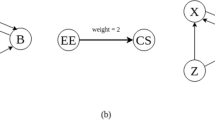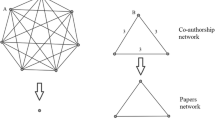Abstract
This paper aims to identify the collaboration pattern and network structure of the coauthorship network of library and information science (LIS) in China. Using data from 18 core source LIS journals in China covering 6 years, we construct the LIS coauthorship network. We analyze the network from both macro and micro perspectives and identify some key features of this network: this network is a small-world network, and follows the scale-free character. In the micro-level, we calculate each author’s centrality values and compare them with citation counts. We find that centrality rankings are highly correlated with citation rankings. We also discuss the limitation of current centrality measures for coauthorship network analysis.



Similar content being viewed by others
References
Albert, R., & Barabási, A. (2002). Statistical mechanics of complex networks. Review of Modern Physics, 74(1), 47–97.
Albert, R., Jeong, H., & Barabási, A. (2000). Error and attack tolerance of complex networks. Nature, 406, 378–382.
Baird, L. M., & Oppenheim, C. (1994). Do citations matter. Journal of Information Science, 20(1), 2–15.
Barabási, A., & Albert, R. (1999). Emergence of scaling in random networks. Science, 286, 509–512.
Barabási, A. L., Jeong, H., Neda, Z., Ravasz, E., Schubert, A., & Vicsek, T. (2002). Evolution of the social network of scientific collaborations. Physica A—Statistical Mechanics and Its Applications, 311(3–4), 590–614.
Brandes, U. (2008). On variants of shortest-path betweenness centrality and their generic computation. Social Networks, 30, 136–145.
Burt, R. S. (1980). Autonomy in a social topology. American Journal of Sociology, 85, 892–925.
Burt, R. S. (2002). The social capital of structural holes. In M. F. Guillén, R. Collins, P. England, & M. Russell (Eds.), New directions in economic sociology (pp. 203–247). Thousand Oaks, CA: Sage Foundation.
Castro, R. D., & Grossman, J. (1999). Famous trails to Paul Erdös. MATHINT: The Mathematical Intelligencer, 21, 51–63.
Chen, P., Xie, H., Maslov, S., & Redner, S. (2007). Finding scientific gems with Google. Journal of Informetrics, 1, 8–15.
Cronin, B., & Shaw, D. (2002). Banking (on) different forms of symbolic capital. Journal of the American Society for Information Science and Technology, 53(14), 1267–1270.
Cronin, B., & Shaw, D. (2007). Peers and spheres of influence: Situating Rob Kling. Information Society, 23(4), 221–233.
Freeman, L. C. (1977). A set of measures of centrality based on betweenness. Sociometry, 40(1), 35–41.
Freeman, L. C. (1979). Centrality in social networks. Conceptual clarification. Social Networks, 1, 215–239.
Frost, C. O. (1979). The use of citations in literary research: A preliminary classification of citation functions. Library Quarterly, 49(4), 399–414.
Garfield, E., & Sher, I. H. (1963). New factors in evaluation of scientific literature through citation indexing. American Documentation, 14(3), 195–202.
Grossman, W. J. (2002). The evolution of the mathematical research collaboration graph. Congressus Numerantium, 158, 201–212.
Hou, H., Kretschmer, H., & Liu, Z. (2008). The structure of scientific collaboration networks in Scientometrics. Scientometrics, 75(2), 189–202.
Jin, X. (1999). A comparison study on the confusion and threat of the United States and Chinese library education. International Information & Library Review, 31, 1–18.
Kretschmer, H. (2004). Author productivity and geodesic distance in bibliographic co-authorship networks and visibility on the Web. Scientometrics, 60(3), 409–420.
Lawani, S. M., & Bayer, A. E. (1983). Validity of citation criteria for assessing the influence of scientific publications—new evidence with peer assessment. Journal of the American Society for Information Science, 34(1), 59–66.
Liu, X., Bollen, J., Nelson, M. L., & Van de Sompel, H. (2005). Co-authorship networks in the digital library research community. Information Processing and Management, 41, 1462–1480.
Liu, L. G., Xuan, Z. G., Dang, Z. Y., Guo, Q., & Wang, Z. T. (2007). Weighted network properties of Chinese nature science basic research. Physica A—Statistical Mechanics and Its Applications, 377(1), 302–314.
Milgram, S. (1967). The small world problem. Psychology Today, 2, 60–67.
Mutschke, P. (2003). Mining networks and central entities in digital libraries. A graph theoretic approach applied to co-author networks. Advances in Intelligent Data Analysis V, 2810, 155–166.
Nascimento, M. A., Sander, J., & Pound, J. (2003). Analysis of SIGMODs coauthorship graph. SIGMOD Record, 32(3), 8–10.
Newman, M. E. J. (2001a). Scientific collaboration networks: I. Network construction and fundamental results. Physical Review E, 64, 016131.
Newman, M. E. J. (2001b). Scientific collaboration networks: II. Shortest paths, weighted networks, and centrality. Physical Review E, 64, 016132.
Newman, M. E. J. (2001c). The structure of scientific collaboration networks. Proceedings of the National Academy of Science of the United States of America, 98(2), 404–409.
Newman, M. E. J. (2003). The structure and function of complex networks. SIAM Review, 45(2), 167–256.
Newman, M. E. J. (2004). Coauthorship networks and patterns of scientific collaboration. Proceedings of the National Academy of Sciences of the United States of America, 101, 5200–5205.
Newman, M. E. J. (2005). A measure of betweenness centrality based on random walks. Social Networks, 27, 39–54.
Nooy, W., Mrvar, A., & Batagelj, V. (2005). Exploratory social network analysis with pajek. Cambridge, UK: Cambridge University Press.
Price, J. D. S. (1965). Networks of scientific papers. Science, 149, 510–515.
Rodriguez, M. A., & Pepe, A. (2008). On the relationship between the structural and socioacademic communities of a coauthorship network. Journal of Informetrics, 2(3), 195–201.
Vidgen, R., Henneberg, S., & Naude, P. (2007). What sort of community is the European conference on information systems? A social network analysis 1993–2005. European Journal of Information Systems, 16(1), 5–19.
Wagner, C. S., & Leydesdorff, L. (2003). Mapping global science using international co-authorships: A comparison of 1990 and 2000. In Proceedings of ninth international conference on scientometrics and informetrics, Beijing, China.
Wang, Y., Wu, Y., Pan, Y., Ma, Z., & Rousseau, R. (2005). Scientific collaboration in China as reflected in coauthorship. Scientometrics, 62(2), 183–198.
Wasserman, S., & Faust, K. (1994). Social network analysis: Methods and applications. Cambridge, UK: Cambridge University Press.
Watts, D. J., & Strogatz, S. H. (1998). Collective dynamics of ‘small-world’ networks. Nature, 393, 440.
Wu, X., & Yuan, F. (1994). Library and information education in the People’s Republic of China: The impact of reform and “opening-up”. Education for Information, 12, 247–257.
Yin, L., Kretschmer, H., Hanneman, R. A., & Liu, Z. (2006). Connection and stratification in research collaboration: An analysis of the COLLNET network. Information Processing and Management, 42, 1599–1613.
Acknowledgements
The authors would like to thank Blaise Cronin, Lokman Meho, Elin Jacob and Alice Robbin for their review of this article. The authors would also like to thank Lijiang Guo and Hui Fang for their assistance.
Author information
Authors and Affiliations
Corresponding author
Rights and permissions
About this article
Cite this article
Yan, E., Ding, Y. & Zhu, Q. Mapping library and information science in China: a coauthorship network analysis. Scientometrics 83, 115–131 (2010). https://doi.org/10.1007/s11192-009-0027-9
Received:
Accepted:
Published:
Issue Date:
DOI: https://doi.org/10.1007/s11192-009-0027-9




